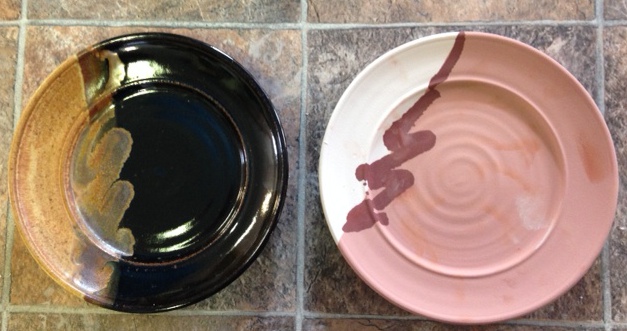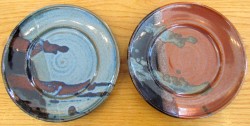See a list of our current glazes, here.
We have a variety of glazes that we offer as options for your stoneware pieces. Each of these glazes has gone through extensive testing. The process of creating a new glaze can take anywhere from 6 months to years! Glazing is a science as well as an art, and we hope this post helps you to understand the chemistry of glazing, and what options we can offer.
Glaze: A vitreous (melted glass) substance fused on to the surface of pottery to form a hard, impervious decorative coating. The first image is how our mocha swirl glaze looks after the last firing. The 2nd image is how it looks before it is fired.

The different colors of our glazes are the result of chemical reactions that take place when we “fire” our pottery. Glazing is not at all like painting. Think of it more as glass than paint. Unlike paint, we are not working with a pigment where the color you see is the color you get. The color develops chemically as the glaze melts during firing. It comes from interaction between the gas, oxygen, and glaze ingredients. The colors in the glaze come from the metal oxides (such as iron oxide or copper oxide) we add to the glaze mixture. Each is varied by the other ingredients in the glaze. Think of it like baking. You need the perfect combination of ingredients and temperature to create a certain color. We cannot “match” colors. There are limits to the colors available in high fire glazes and as explained above, the process is not totally controllable. Variation is the one guarantee.
Pattern: Each glaze pattern is created through a variety of glazing techniques. Betsy uses brushes, sponges, and squirt bottles to apply the glaze. She also dips some pieces and pours glaze onto others. Each of her methods creates a different pattern. This is an area where we are happy to help you make modifications on your piece. If you don’t like a squiggle, we can omit it. Maybe you like a little more of one color and a little less of another. We have already tested these patterns and slight variations are an option. We can discuss ideas you may have to see if they are doable. Remember to think of glaze like watercolor paint. Lines are blurred, and there is a fluidity with the medium. Here is an example of 2 plates with the same pattern using different glazes.

Firing: Betsy has 20+ variables to consider when glazing and firing. Any one of these can alter the color of the glaze. Two of these variables are the wind speed and direction. The wind changes the way the kiln breathes. The way the gases leave the kiln affects the chemical reactions and therefor the color. This is one of many uncontrollable factors which affect the firing. Temperature and humidity are other variables which can change the chemical reactions during a firing. Outside forces are not the only variables Betsy needs to consider. Where she place the pots inside the kiln also affects the coloring. Pots placed lower in the kiln are closer to the flame and therefor hotter, while pots on the top shelf fire at a cooler temperature.
Inside the kiln, chemical reactions are taking place. Some of these reactions can not always be controlled. Flashing is the transference of a material from one pot to another during firing. It is caused by a material becoming volatile during firing, in which some of the volatilized material settles on the same or a separate pot. This result is a flash of red on another piece. Our yellow salt glaze is the most susceptible to this. It doesn’t happen often, but we see the pieces that flash as special. Some potters intentionally induce flashing, especially during pit firing.
